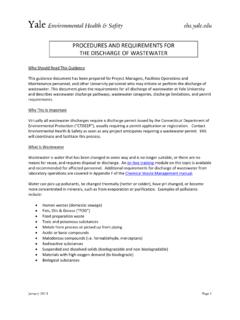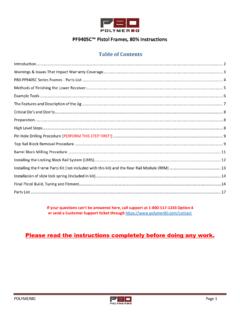Transcription of Yale
1 Yale Environmental Health & Safety Equipment/Task Name: VERTICAL MILLING MACHINE Equipment/Task Hazard Class: 4 & 5 Shop Name: Shop Hazard Class: Purpose The vertical milling machine is a precision tool used for shaping and fabrication by the removal of stock typically from metallic work pieces. Plastics and other materials can also be machined on the mill depending upon tooling and material. Mill controls may be manually operated, computer numerical controlled (CNC), or a combination of both. Mill machining and material removal is typically made by a rotary cutter held in a spindle. Cutting options are more sophisticated and variable than a drill press by virtue of a moveable table and/or vise (x and y-axes) and vertical spindle movement (z-axis).
2 Many vertical mills also have a rotatable turret for the upper cutting head which provides even greater machining options (b-axis). A diagram is included in this procedure to help illustrate the varying axes. Some of the common operations that can be performed on the mill include: Milling These operations provide a flat surface or spot on a work piece, typically with a specific orientation to other work piece features, surfaces, or another piece. Facing is sometimes used on an irregular shaped work piece to true one surface at a time to ensure that all surfaces have appropriate specific geometric relationships with each other. Slotting or keyways Slots, flats, or keyways can be cut with proper fixturing.
3 Drilling or boring Where specific orientations are required between work piece features, the vertical mill provides the means to accurately index and machine holes. Hazards As with all shop tools, there are many potential hazards associated with the use of a milling machine. Full sized milling machines are Class 5 tools while small/bench top versions are Class 4 tools ( ). Particular hazards associated with vertical milling machine are listed below. Note that the list is not exhaustive as unusual or specialized uses may generate additional unique hazards. A diagram is included in this procedure as a reference for the machine component names. Rotating Cutters and Spindle Large amounts of energy are embodied in rotating parts.
4 Do not set spindle speed at excessive RPM s.. In emergencies and when the emergency stop is activated, the machine will take much longer to stop. Limit spindle rotation to 1000 RPM or slower whenever possible Potential for loose clothing, jewelry, hair, or other items can become entangled in rotating parts, potentially drawing the operator close to or into the cutter or spindle. Yale Environmental Health & Safety 135 College Street 203-785-3550 Page 1 Hazards (cont d) Sharp Tooling and Edges on Work Piece Potential for cuts, lacerations, and puncture wounds. Fresh cuts on work piece may produce burrs and other sharp edges. Flying or Rotating Objects Cutting and boring activities can generate sharp flying chips posing skin, facial, and eye injury hazards.
5 Work pieces, cutters and other tooling, or clamps can become disengaged and rotate or be flung across the room. Insufficiently secured work pieces can be rotated at high speed, potentially striking or crushing fingers, hands, or other close body parts. Hot Objects and Components The friction associated with cutting generates significant amounts of heat that can cause skin burns, flying sparks, and fire hazards. Power Feed and Computer Controls These components introduce additional rotating and moving objects that can create pinch points and blunt object injury. Crush & Drop Hazards During machine operation the operator usually concentrates their attention towards the cutting action.
6 Usually the machine is in motion and unexpected crush hazards can develop. Pinch points / in-running nip points: Pinchpoints and in-running nip points can be found between the: o Cutting tool and work piece o Cutting tool and work holding devices Pinchpoints and in-running nip points can cause bruising, crushing, and even amputation hazards, and can also offer additional entanglement hazards to clothing and other loose hanging materials. Limitations Check with the shop instructor or supervisor before machining unusual or unique materials such as composites, plastics, titanium, magnesium, or beryllium copper. These materials may create secondary hazards including fire and toxic fumes.
7 One of the most significant limitations to mill use is the ability to properly and securely clamp or fixture the work-piece to the machine table. This must be done in such a way that it is secure and the physical shape/size allows for full travel and clearance with all machine components. The weight of the work piece can be a limitation. This can be more problematic on smaller, bench top style mills. Verify manufacture specifications in advance. At times, a work piece may extend off of the machine table. In this situation provide safety awareness barriers for other employees working in the shop. Also, beware of pinch point between the overhanging component and other shop equipment.
8 Required Personal Protective Equipment Refer to the Shop Safety Postings and instructions provided by the Shop Supervisor. Shop specific required PPE: Required Training Applicable Shop Rules o Student Shop Rules ( ) o Professional Shop Rules ( ) Yale Environmental Health & Safety 135 College Street 203-785-3550 Page 2 Required Training (cont d) For Class 2 through 5 Student Shops, r eview and signing of the Yale University Shop/Tool Use Safety Agreement ( ). Shop Supervisors or Instructors must evaluate the tool user based on successful demonstration of the Training Competencies and Practical Exercises listed below as applicable. Training Competencies: Identify the uses, limitation, and hazards of the machine.
9 Demonstrate use of appropriate clothing, work boots and correct personal protective equipment. Demonstrate how to inspect the mill and adjust all components for selected operation. Properly demonstrate the equipment start-up process. Demonstrate how to secure or fixture various work pieces. Demonstrate safe milling operation, including using adequate lubrication and appropriate spindle speed and feed for work piece material, cutting bit selected and secure work holding methods Demonstrate how to properly set spindle speeds Shop specific training requirements: Authorized Tool Users Shop Supervisor, Shop Monitors and those authorized by shop supervision to operate the tool.
10 Tool Safety Rules Observe and follow all Yale Professional or Student Shop Rules as posted. Report any safety concerns to the shop supervisor immediately. Understand and follow manufacturer operating procedures. Inspect the cutting tool for damage prior to use. Verify all guards are in place and adjusted properly. Do not bypass any safety devices. Always stay at the machine while it is running. Clean the machine completely after use. Report any malfunction or damage to the Shop Supervisor after tagging the machine tool Out of Service, do not use . Maintain exclusive control of the machine. Don t allow anyone else to touch the machine while in operation. Do not make measurements of the stock while the machine is rotating.











